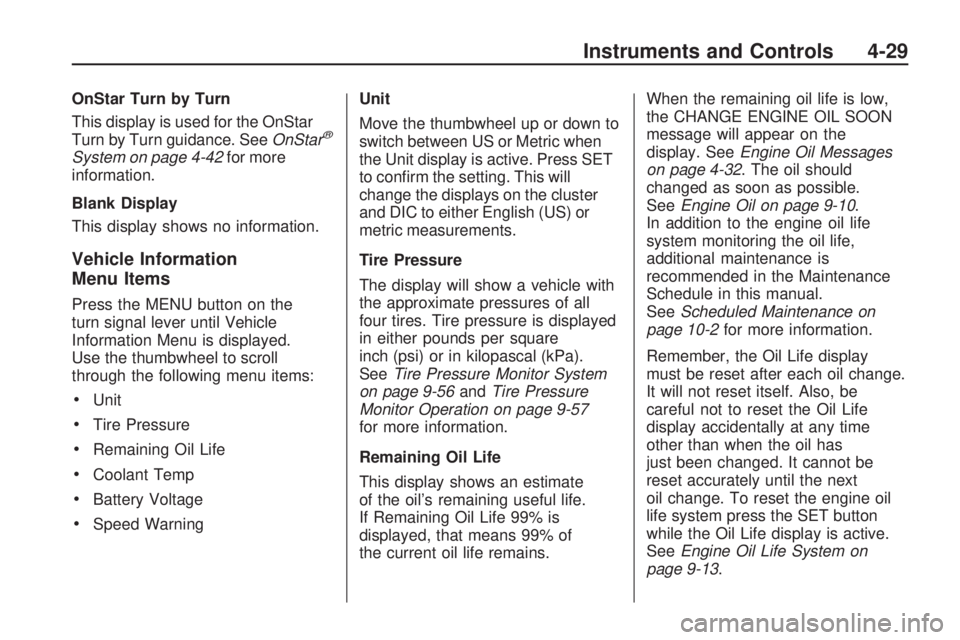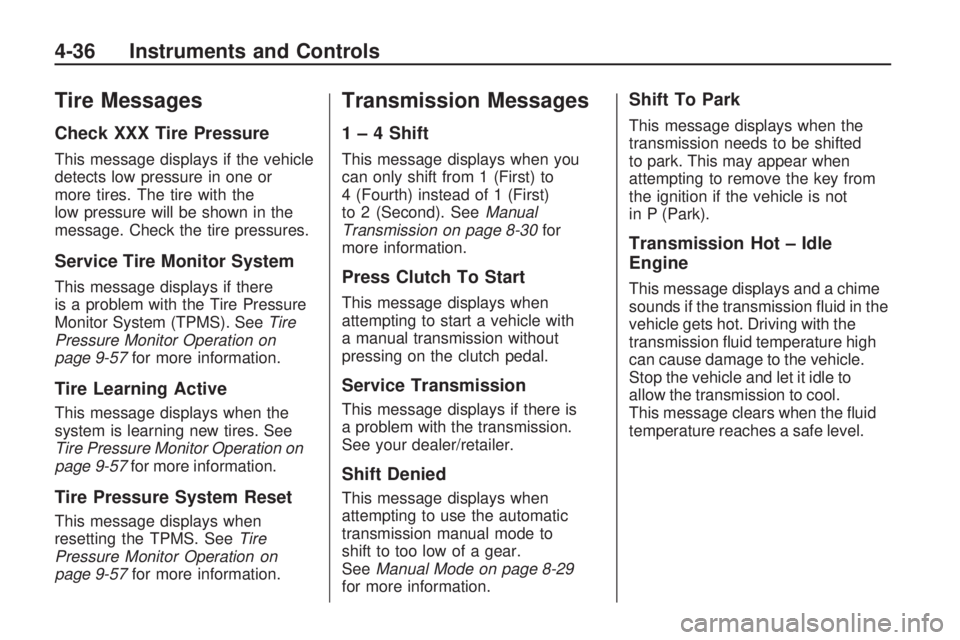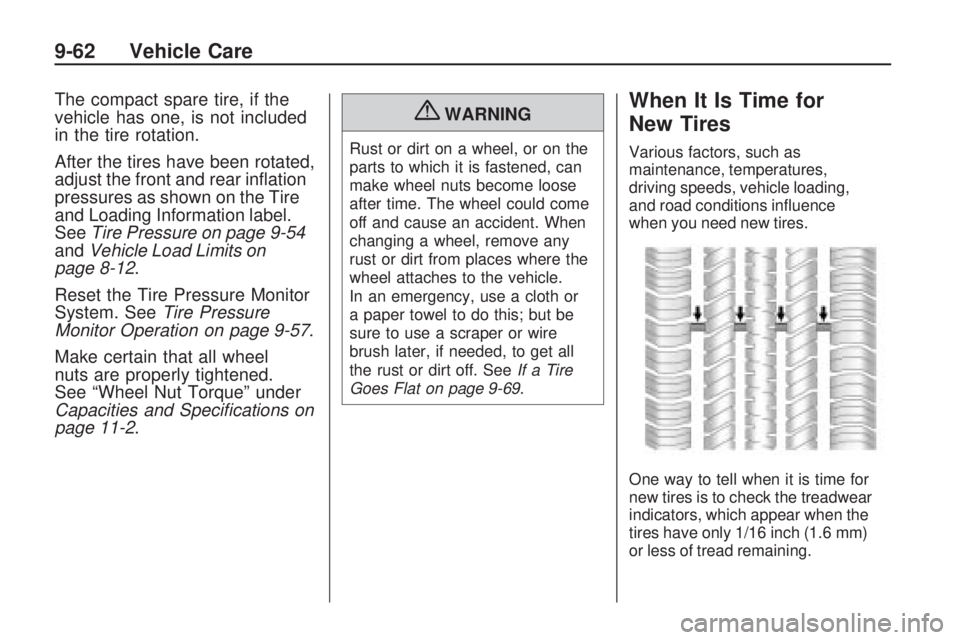tire pressure reset CHEVROLET CAMARO SS 2010 Owners Manual
[x] Cancel search | Manufacturer: CHEVROLET, Model Year: 2010, Model line: CAMARO SS, Model: CHEVROLET CAMARO SS 2010Pages: 372, PDF Size: 1.91 MB
Page 109 of 372

OnStar Turn by Turn
This display is used for the OnStar
Turn by Turn guidance. SeeOnStar
®
System on page 4-42for more
information.
Blank Display
This display shows no information.
Vehicle Information
Menu Items
Press the MENU button on the
turn signal lever until Vehicle
Information Menu is displayed.
Use the thumbwheel to scroll
through the following menu items:
•Unit
•Tire Pressure
•Remaining Oil Life
•Coolant Temp
•Battery Voltage
•Speed WarningUnit
Move the thumbwheel up or down to
switch between US or Metric when
the Unit display is active. Press SET
to confirm the setting. This will
change the displays on the cluster
and DIC to either English (US) or
metric measurements.
Tire Pressure
The display will show a vehicle with
the approximate pressures of all
four tires. Tire pressure is displayed
in either pounds per square
inch (psi) or in kilopascal (kPa).
SeeTire Pressure Monitor System
on page 9-56andTire Pressure
Monitor Operation on page 9-57
for more information.
Remaining Oil Life
This display shows an estimate
of the oil’s remaining useful life.
If Remaining Oil Life 99% is
displayed, that means 99% of
the current oil life remains.When the remaining oil life is low,
the CHANGE ENGINE OIL SOON
message will appear on the
display. SeeEngine Oil Messages
on page 4-32. The oil should
changed as soon as possible.
SeeEngine Oil on page 9-10.
In addition to the engine oil life
system monitoring the oil life,
additional maintenance is
recommended in the Maintenance
Schedule in this manual.
SeeScheduled Maintenance on
page 10-2for more information.
Remember, the Oil Life display
must be reset after each oil change.
It will not reset itself. Also, be
careful not to reset the Oil Life
display accidentally at any time
other than when the oil has
just been changed. It cannot be
reset accurately until the next
oil change. To reset the engine oil
life system press the SET button
while the Oil Life display is active.
SeeEngine Oil Life System on
page 9-13.
Instruments and Controls 4-29
Page 116 of 372

Tire Messages
Check XXX Tire Pressure
This message displays if the vehicle
detects low pressure in one or
more tires. The tire with the
low pressure will be shown in the
message. Check the tire pressures.
Service Tire Monitor System
This message displays if there
is a problem with the Tire Pressure
Monitor System (TPMS). SeeTire
Pressure Monitor Operation on
page 9-57for more information.
Tire Learning Active
This message displays when the
system is learning new tires. See
Tire Pressure Monitor Operation on
page 9-57for more information.
Tire Pressure System Reset
This message displays when
resetting the TPMS. SeeTire
Pressure Monitor Operation on
page 9-57for more information.
Transmission Messages
1 – 4 Shift
This message displays when you
can only shift from 1 (First) to
4 (Fourth) instead of 1 (First)
to 2 (Second). SeeManual
Transmission on page 8-30for
more information.
Press Clutch To Start
This message displays when
attempting to start a vehicle with
a manual transmission without
pressing on the clutch pedal.
Service Transmission
This message displays if there is
a problem with the transmission.
See your dealer/retailer.
Shift Denied
This message displays when
attempting to use the automatic
transmission manual mode to
shift to too low of a gear.
SeeManual Mode on page 8-29
for more information.
Shift To Park
This message displays when the
transmission needs to be shifted
to park. This may appear when
attempting to remove the key from
the ignition if the vehicle is not
in P (Park).
Transmission Hot – Idle
Engine
This message displays and a chime
sounds if the transmission fluid in the
vehicle gets hot. Driving with the
transmission fluid temperature high
can cause damage to the vehicle.
Stop the vehicle and let it idle to
allow the transmission to cool.
This message clears when the fluid
temperature reaches a safe level.
4-36 Instruments and Controls
Page 294 of 372

The compact spare tire, if the
vehicle has one, is not included
in the tire rotation.
After the tires have been rotated,
adjust the front and rear inflation
pressures as shown on the Tire
and Loading Information label.
SeeTire Pressure on page 9-54
andVehicle Load Limits on
page 8-12.
Reset the Tire Pressure Monitor
System. SeeTire Pressure
Monitor Operation on page 9-57.
Make certain that all wheel
nuts are properly tightened.
See “Wheel Nut Torque” under
Capacities and Speci�cations on
page 11-2.{WARNING
Rust or dirt on a wheel, or on the
parts to which it is fastened, can
make wheel nuts become loose
after time. The wheel could come
off and cause an accident. When
changing a wheel, remove any
rust or dirt from places where the
wheel attaches to the vehicle.
In an emergency, use a cloth or
a paper towel to do this; but be
sure to use a scraper or wire
brush later, if needed, to get all
the rust or dirt off. SeeIf a Tire
Goes Flat on page 9-69.
When It Is Time for
New Tires
Various factors, such as
maintenance, temperatures,
driving speeds, vehicle loading,
and road conditions influence
when you need new tires.
One way to tell when it is time for
new tires is to check the treadwear
indicators, which appear when the
tires have only 1/16 inch (1.6 mm)
or less of tread remaining.
9-62 Vehicle Care
Page 334 of 372

ServiceMaintenanceIMaintenance II
Change engine oil and filter. Reset oil life system. ••
Engine coolant level check. ••
Windshield washer fluid level check. ••
Tire inflation pressures check. ••
Tire wear inspection. ••
If tire rotation is recommended for the vehicle, rotate tires. ••
Fluids visual leak check. ••
Engine air cleaner filter inspection (vehicles driven in dusty conditions only). ••
Brake system inspection. ••
Steering and suspension inspection. •
Engine cooling system inspection. •
Windshield wiper blades inspection. •
Body components lubrication. •
Restraint system components check. •
Automatic transmission fluid level check. •
Rear axle fluid level check. •
Engine air cleaner filter inspection (vehicles not driven in dusty conditions). •
Passenger compartment air filter replacement. •
10-6 Service and Maintenance